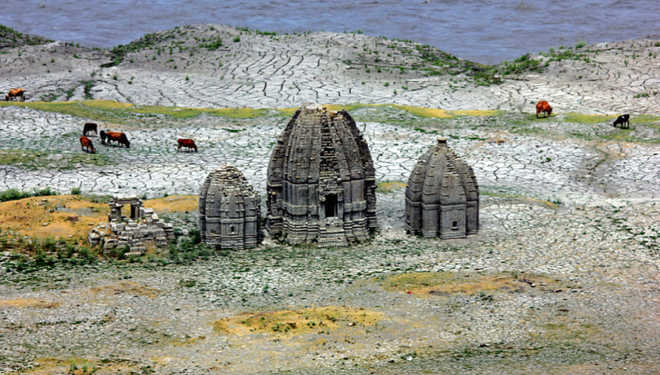Bilaspur’s submerged shrines
Raaja Bhasin
The work on Bhakra Dam began in 1955 on the river Satluj and was completed in 1962. As a result of building the 225.5 metre high-gravity dam, about 30,000 acre land in and around the town of Bilaspur was submerged.
The old town of Bilaspur, built in the 17th century, which was considered to be the first planned town in the hills of India, was also submerged. Apart from the town, fourteen villages came under water. The town of Bilaspur today lies higher and was built when the old town prepared to go under the waters of the vast reservoir — the Gobind Sagar.
The most significant loss in the submersion was of the 28 large and small temples of Bilaspur. Most of these were built in the classical ‘nagara’ style. Of these, three were large shrines while the others were small. The images and idols were placed elsewhere. Some carvings were shifted to the museum in Shimla. The now-submerged town was rich with history and built heritage.
The core of this heritage was the palace and temples. The temples were well-endowed with substantial agricultural lands for their upkeep. Despite their prominence in Bilaspur, these remained unstudied by scholars and the only research done was by Dr Hermann Goetz in the 1950s.
The Shri Ranganath Temple cluster was in old Bilaspur and was a group of five large and small temples placed in the centre of the town. The temples were constructed in stone masonry. A flight of stairs led to the top of a substantial platform. This was the main saivite temple and housed a shivalingam and statues of Shiva and Parvati. When Dr Goetz studied the temples, he noted that a plinth in the temple was similar to shrines in Ashok and Pattadakal, where the ruling house of Bilaspur is said to have come from.
Dr VC Ohri served as the curator of the State Museum in Shimla and was responsible for rescuing two sculptures from Shri Ranganath Temple in 1973 and placing them in the museum. Of the temples, he observed in his book Arts of Himachal: “(The) Ranganath temple must have been rebuilt some centuries back using the sculptures of the eighth-ninth century. Some carvings which are close in style to late Pritahara period appear at the plinth and the upper structure of the temple seems to belong to even a later period.”
The quality of the structures has been compared with the Basheshwara Mahadev temple at Bajaura, near Kullu, and the monolithic shrine of Masrur in Kangra. Apart from the primary temple dedicated to Shiva, the other four shrines were dedicated to Sati, Kali, Ganesh, Hanuman, Shitala Devi and Chhadol Rani.
The Khanmukeshwara temples (also called the Shanmukeshwara Temples) are two temples that stand side by side and are visible when the water level of the Gobind Sagar recedes. One is dedicated to Shiva and the other to Kartikeya; both were built on raised platforms. The one dedicated to Kartikeya, is one of the only two significant shrines dedicated to this deity (the other is in Kumaon).
The ‘Haridwar and Rishikesh’ of Bilaspur were replicas with shrines of these two sacred spots. These were built at Bilaspur by the rulers for the people who could not go to these two sacred places on pilgrimage. A 40-room haveli was also built by Raja Bijai Chand for his own use. All have been submerged. Some other submerged temples of Bilaspur are the Gopalji temple, the Karkari ka Mandir, the temple at Ghar and the Punj-Rukhi temple. A rare sight and one that is beholden to witness is when the reservoir’s water recedes and these ‘lost treasures’ come in sight.
A rare sight
- The Khanmukeshwara temples (also called the Shanmukeshwara Temples) are two temples that stand side by side and are visible when the water level of the Gobind Sagar recedes. One is dedicated to Shiva and the other to Kartikeya; both were built on raised platforms. The one dedicated to Kartikeya, is one of the only two significant shrines dedicated to this deity (the other is in Kumaon)
- The ‘Haridwar and Rishikesh’ of Bilaspur were replicas with shrines of these two sacred spots. These were built at Bilaspur by the rulers for the people who could not go to these two sacred places on pilgrimage
- A 40-room haveli was also built by Raja Bijai Chand for his own use. All have been submerged
- Some other submerged temples of Bilaspur are the Gopalji temple, the Karkari ka Mandir, the temple at Ghar and the Punj-Rukhi temple
(The) Ranganath temple must have been rebuilt some centuries back using the sculptures of the eighth-ninth century. Some carvings which are close in style to late Pritahara period appear at the plinth and the upper structure of the temple seems to belong to even a later period. Excerpts from Dr VC Ohri’s book ‘Arts of Himachal’
(The writer is an author, historian and journalist)









